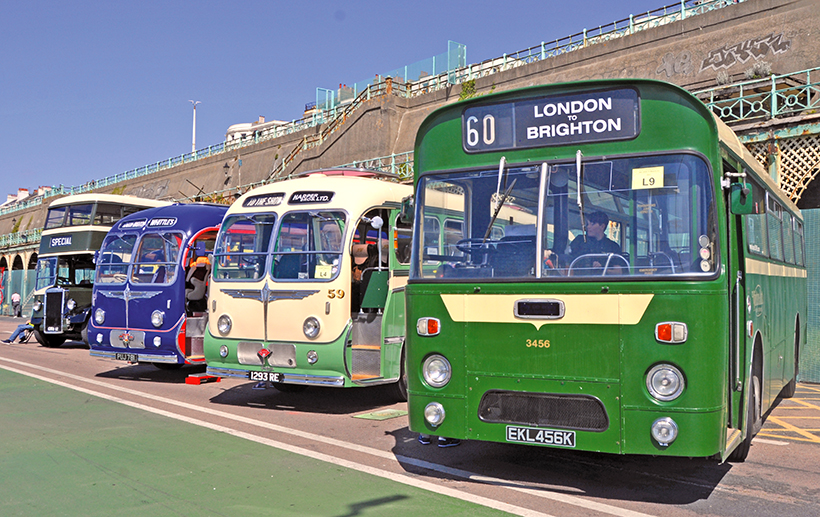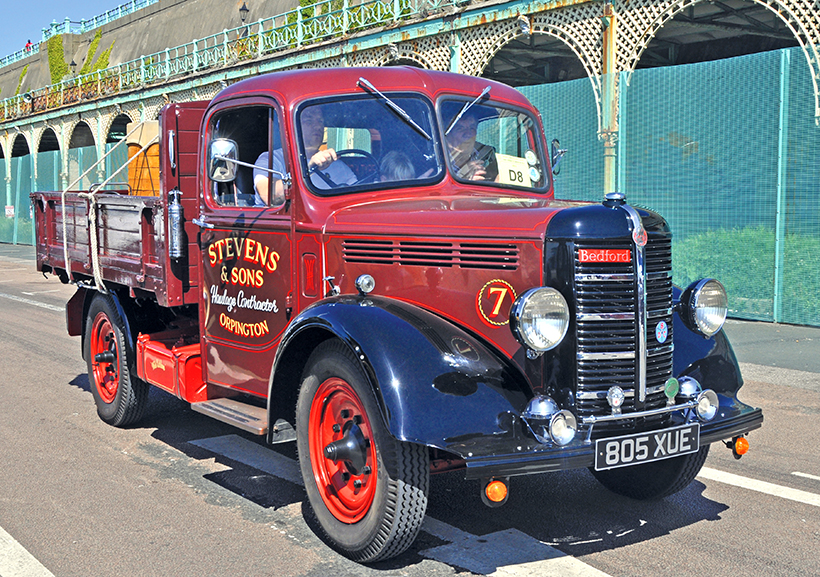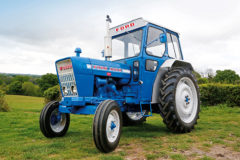London to Brighton Historic Commercial Vehicle Run
Posted by Chris Graham on 12th July 2022
We report on the 60th running of the London to Brighton Historic Commercial Vehicle Run which, this year, had 170 entrants.

Built to operate between main line terminal stations in London, this 1936 Leyland ‘one-and-a-half deck’ bus was making its first public appearance in over 30 years. (Pic: Peter Love)
It was 60 years ago that the first Historic Commercial Vehicle Run took place, on Sunday May 13th, 1962. Founded in 1958 as the Historic Commercial Vehicle Club following a rally the previous year at Lord Montagu’s Beaulieu, the early runs started from the former Transport Museum at Clapham.

This 1934 Commer Raider removal van with Luton coachwork went with a family who emigrated to Ireland in 1955, but was repatriated in 1989 and restored in 2010. (Pic: Peter Love)
A change of date from the first Sunday in May to the second Sunday has proved the right decision, following the bad year when entrants were stuck in traffic queues for a giant car boot sale just south of Crawley, and fighting with bank holiday weekend traffic to the coast.

A former petrol tanker converted to a tipper in the 1930s, this 1929 Leyland QH6 entered preservation in the early 1960s. (Pic: Peter Love)
The only negative now is the smaller amount of available space when hiring Madeira Drive for the day, due to the city’s council inaction over restoring the famous arches; a long-time classic backdrop to vehicles displayed at the end of the run, but now sheeted-off. This considerably reduces the width of the drive, and results in some horrible ‘pinch points’ for vehicles to snake through between the finish line and their allocated parking areas. As to the form-filling paperwork required by the city’s ‘green’ council, which include such gems as ‘Do your generators use bio-diesel?… the less said, the better…

A former concrete mixer converted to a tipper, this 1971 Albion Reiver RE 229 takes a faster lane than the 1977 Ford DT tipper. (Pic: Peter Love)
A total of 180 vehicles had been registered for the run and the organisers had already been informed of 10 that would not be participating due to mechanical (or human) failures, thus 170 vehicles were expected to cross the finish line.

Sights of the ’60s: 1960 Bedford ‘J’ Type, 1963 Ford Thames Trader, 1967 Ford D recovery lorry, 1961 Ford Thames Trader sit with a 1980 Ford D Series lorry. (Pic: Colin Tyson)
The route south has now eliminated the previous halfway stop in Crawley High Street. Participants now leave the A23 at the northern end of Horley and use the B2036 down to Balcombe, Cuckfield, Burgess Hill and Hassocks before climbing Clayton Hill on the South Downs and rejoining the A23 at Pyecombe for the final leg into Brighton. With no marshals or signs on route, it seemed to be down to individual drivers to find their own way via this route – they certainly didn’t all go the same way!

A last-minute change for the London Bus Museum’s entry, with RT 4779 replacing its 1968 Routemaster, about to overtake an ex-Army 1944 AEC Matador timber tractor.
First over the finishing line were the usual suspects – the zippier of the military vehicles and the little GPO Morris vans.

A fine example of traditional sign-writing on this 1962 ERF KV with matching Eagle semi-trailer. (Pic: Peter Love)
Congratulations have to go once again to Fraser Clayton and his organising team of officials, as well as the two Brians in the commentary bus – seasoned veterans Johnson and Tullett – who kept everyone informed throughout the day.

Contrasting Bedfords: a 1958 C Type and an earlier OSB tipper lorry from 1948.
The sun shone and the event was once again a good advertisement for the vintage vehicle movement.

The last bus to be delivered new to Maidstone & District in traditional green and cream livery in 1972 (nearest the camera), together with a 1959 Guy coach with distinctive Burlingham Seagull body; a Leyland Tiger Cub of 1957 with the same body and a 1948 Leyland Titan double-decker. (Pic: Colin Tyson)

A stunning, 1949 Bedford ‘K’ dropside lorry arrives in Brighton. Exported new to New Zealand, this one returned to the UK 15 years ago, with the engine recently rebuilt by owner John Stevens. (Pic: Colin Tyson)
The event report comes from the latest issue of Old Glory, and you can get a money-saving subscription to the magazine simply by clicking HERE

Previous Post
HMS Victory’s 10-year renovation plan announced

Next Post
Marvel at this superb 1973 Ford 4000 restoration



